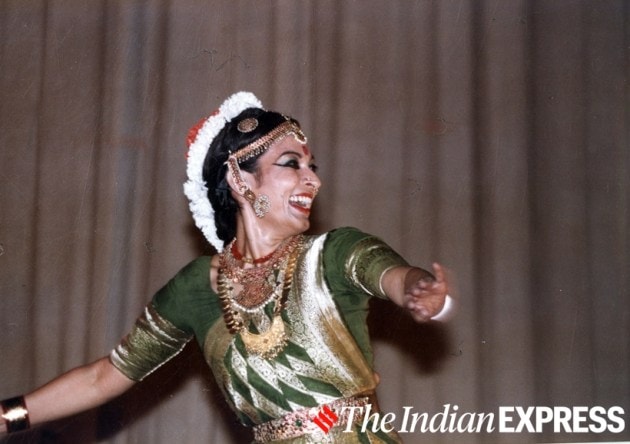On International Dance Day, a look at some of India’s famous dance forms and their exponents
International Dance Day, celebrated annually on April 29, was introduced in 1982 by the International Dance Council, a UNESCO partner NGO.
April 29, 2023 17:00 IST 1 / 11
1 / 11International Dance Day, celebrated annually on April 29, was introduced in 1982 by the International Dance Council, a UNESCO partner NGO. The objective behind dedicating a separate day for this artform was to draw the attention of the masses towards the art of dance. On this occasion, here is a look at some of the popular dance forms practised around the country, and the major exponents of the same. (Express Archive)
 2 / 11
2 / 11Lucknow Gharana Kathak: It has been said that in Lucknow, Kathak developed mainly in the court of Nawab Wajid Ali Shah where artists who had migrated from Delhi used to perform here. The Lucknow gharana of Kathak dance is hallmarked by smooth graceful movements, precision and delicacy and this dance type is paired with classical music like thumri, dadra and horis. (Express Archive)
 3 / 11
3 / 11Pandit Birju Maharaj, the maestro of Kathak and one of India’s most recognised and beloved artists, was the face and torchbearer of Lucknow Gharana Kathak. A pioneer in Indian classical dance, he was awarded the Padma Vibhushan in 1986 for his contributions to the field of performing arts. (Express Archive)
 4 / 11
4 / 11Odissi: Odissi, also referred to as Orissi in old literature, is a major ancient Indian classical dance that originated in the temples of Odisha. It is traditionally a dance-drama genre of performance art where the artists and musicians play out a story, a spiritual message or devotional poem from the ancient Hindu texts. (Express Archive)
 5 / 11
5 / 11Sonal Mansingh is a prominent Indian classical dancer who specialises in Odissi. Besides being a dancer, Sonal Mansingh is a well-known choreographer, teacher, orator and a social activist. For her contributions towards promoting ‘Classical dances’, she has received accolades from many national and international organizations. She was the youngest recipient of Padma Bhushan in 1992. (Express Archive)
 6 / 11
6 / 11Manipuri: The Manipuri Dance, also referred to as the Manipuri Raas Leela, is a jagoi and is one of the eight major Indian classical dance forms, originating from the state of Manipur. The dance form is imbued with the devotional themes of Madhura Raas of Radha-Krishna and characterised by gentle eyes and soft peaceful body movements. (Express Archive)
 7 / 11
7 / 11Darshana Jhaveri, the youngest of the four Jhaveri sisters, is a leading Indian exponent of Manipuri dance. She is a disciple of Guru Bipin Singh, and started performing on stage in 1958 along with her sisters. She is one of the founders of the Manipuri Nartanalaya in 1972, which popularised Manipuri dance in India. (Express Archive)
 8 / 11
8 / 11Bharatanatyam: Bharatanatyam, presumably the oldest classical dance heritage of India, is regarded as the mother of many other Indian classical dance forms. Conventionally a solo dance performed only by women, it initiated in the Hindu temples of Tamil Nadu and eventually flourished in South India. Theoretical base of this form traces back to ‘Natya Shastra’, the ancient Sanskrit Hindu text on the performing arts. (Express Archive)
 9 / 11
9 / 11Mallika Sarabhai is a leading name in the field of Bharatnatyam. She led as the co-director at the Ahmadabad-based performing arts academy 'Darpana' which her mother had been running earlier. She is also a well-acclaimed choreographer who has choreographed short dances and theatre dance. (Express Archive)
 10 / 11
10 / 11Kuchipudi: Kuchipudi, a pre-eminent Indian classical dance form counted among ten leading classical dance forms of India, is a dance-drama performance art that originated in a village of Krishna district of Andhra Pradesh, India. Similar to all leading Indian classical dance forms, Kuchipudi too evolved as a religious art rooting back to the age-old Hindu Sanskrit text ‘Natya Shastra’ and connects traditionally with temples, spiritual faiths and travelling bards. (Express Archive)
 11 / 11
11 / 11If we ever think of how ‘Kuchipudi’ dance form found global limelight, the success has to be attributed to the Guru of Kuchipudi dance form, Guru Vempati Chinna Satyam. He systemised Kuchipudi and bought the dance form more close to the standards of ‘Natya Shastra’, with introduction of elements such as ‘Chari’, a different style of leg movements. (Express Archive)










